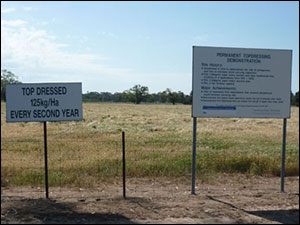Permanently Top Dressed Experiment (PTDE) - Rutherglen
|
The PTDE was established in 1914 to identify the long term effects of fertiliser application on pasture and animal production. |  The PTDE sign at Rutherglen reads 'Permanent top dressing experiment' |
Outputs
The PTDE site has provided measurement of soil acidification processes due to nitrate leaching, carbon cycling and product removal, mechanism of lime amelioration, phosphorus dynamics, pasture production and animal nutrition. The PTDE site also provides a continuous data set for the impact of sheep grazing on soil and pasture persistence over time. It contains a native pasture from which time series comparisons can be made. The scientific publications arising from this site are listed below.
Experimental Design
Since the PTDE site began in 1914, three treatments of phosphorus have been applied every second year to three paddocks. Each paddock is split in half to create six plots each of 0.5 hectares. There are two management options (hay cut, and pasture grazed) for each treatment of phosphorus. There is no replication of the demonstration plots.
The three treatments of phosphorus applied every second year include:
- 0 kg single superphosphate per hectare (native pasture)
- 125 kg single superphosphate per hectare
- 250 kg single superphosphate per hectare
Despite some modifications to management, the three treatments have remain unchanged since 1914.
Pasture production, soil chemistry, and livestock data have been collected to support the production of numerous journal papers. Soil data collected post-1990 adheres to the Australian Soil and Plant Analysis Council’s proficiency standards.
Related Publications
Hayes JE, Richardson AE and Simpson RJ (2000) Components of organic phosphorus in soil extracts that are hydrolysed by phytase and acid phosphatase. Biology and Fertility of Soils 31, 279–286.
McLaughlin MJ, Stevens DP, Keerthisinghe G, Cayley JWD and Ridley AM (2001) Contamination of soil with fluoride by long-term application of superphosphates to pastures and risk to grazing animals. Australian Journal of Soil Research 39, 627–640.
Ridley AM, Slattery WJ, Helyer KR and Cowling A (1990a) Acidification under grazed annual and perennial grass based pastures. Australian Journal of Experimental Agriculture 30, 539–544.
Ridley AM, Slattery WJ, Helyer KR and Cowling A (1990b) The importance of the carbon cycle to acidification of a grazed annual pasture. Australian Journal of Experimental Agriculture 30, 529–537.
Schefe CR, Patti AF, Clune TS and Jackson WR (2007) Soil amendments modify phosphate sorption in an acid soil: the importance of P source (KH2PO4, TSP, DAP). Australian Journal of Soil Research 45, 246-254.
Schefe CR, Patti AF, Clune TS and Jackson WR (2008) Organic amendment addition enhances phosphate fertiliser uptake and wheat growth in an acid soil. Australian Journal of Soil Research 46, 686-693.
Schefe CR, Patti AF, Clune TS and Jackson WR (2008) Organic amendments increase soil solution phosphate concentration in an acid soil: A controlled environment study. Soil Science 173, 267-276.
Schefe CR, Patti AF, Clune TS and Jackson WR (2008) Interactions between organic amendments and phosphate fertilisers modify phosphate sorption processes in an acid soil. Soil Science 173, 433-443.
Trial custodian
Dr Cassandra Schefe - cassandra.schefe@depi.vic.gov.au


